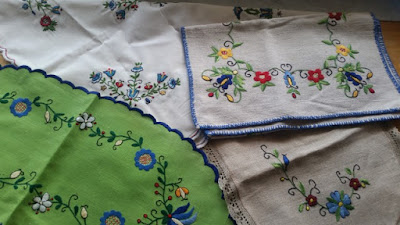Threads of Heritage
Anna Garland
Full of vibrant colors and composed from Kashubian designs, these table runners and doylies were prepared and embroidered by my mother as a hobby. The tradition originated from the small village of Żukowo and was initiated by the Norbertine nuns. At the beginning, all embroidery was monochromic and only decorated with silver or gold threads. Now however, many colors intertwine. Royal blue represents all the beautiful lakes of that region, light blue reminds the viewer of the blue sky, navy blue refers to the depth of the Baltic sea, yellow is the sun and the harvesting fields of Kashubian region, green represents the many forests, red is the blood that each Kashubian is ready to shed in defense of their region and black represents the ground that is ready to be seeded.
The colors and even embroidered pieces themselves didn't have much meaning to me back in Poland, but now, far away from my homeland, they have become a crucial link to my identity and ancestry.
The presence of this delicate embroidery at my house is a constant reminder of my country. At the same time, my kids and their friends become familiar with the story behind them, as they often ask questions after they notice them on my tables. In the future, I am hoping to pass down the beautiful handmade creations to my children, so maybe they can explain to their own kids where the embroideries and their family came from and why the designs were so special to me.
My first accouter with Kashubian embroidery was at a very young age. Most women in my family were familiar with this amazing folk art; knowledge and talent was passed from generation to generation. Our grandmothers, mothers, aunts and many other members of the family found these amazing skills very rewarding. Embroidery was prominent in every traditional household; folk art was brought to life on sheets (mostly pillows and duvets), table clothes, doylies and even blouses for special occasions. My mother mostly specialized in table clothes, table runners, place mats and doylies (in the picture) and I am very grateful for her hard work and dedication. I have tried to carry on the tradition and successfully completed a few small projects.
In Kashubian embroidery the leading motifs and compositions include local wild flowers. In many embroidery arrangements a dominant element involves the “tree of life” with branches that are not allowed cross, representing the idea that human life should be straight and transparent.
Today the appreciation of such a skill seems to be greater than ever because it is far away from home. Infused with great memories from Poland, these embroideries are the only tangible piece of home that I can pass down to the next generation.
Reference: https://www.zukowo.pl/files/docs/szkoly_haftu.pdf
